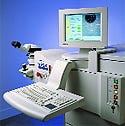Originally Published MDDI February 2006 Ophthalmics: Focusing on Profit
February 1, 2006
Ophthalmics: Focusing on Profit
The past year saw three billion-dollar-plus mergers in the ophthalmics industry. In fact, the deals accounted for three of the four largest acquisitions completed in the device industry in 2005. Advanced Medical Optics (AMO; Santa Ana, CA) bought Santa Clara, CA–based Visx Inc. for $1.153 billion in May. The Cooper Companies Inc., based in Lake Forest, CA, bought Ocular Sciences Inc. (OSI; Concord, CA) for $1.111 billion in January. And Carl Zeiss Ophthalmic Lens Div. (Aalen, Germany) bought San Diego–based Sola International Inc. for $1.076 billion in March.
|
Why all the activity? “There are a couple of reasons for the strong growth seen in the ophthalmics sector,” says Steven M. Hamill, principal of equity research at Minneapolis-based Piper Jaffray. One reason, he says, is that the ophthalmics industry is a more direct-to-consumer business than many medical device sectors. “In many cases, it is the patient who is paying for the treatment, as opposed to a third-party government or private insurer. That is a real benefit that is showing in this sector.”
Because of this direct-to-consumer business, Hamill explains, it is easier for innovative companies to develop a market and get a premium price for bringing a new technology to consumers. “A patient is more willing to pay for a technology than a private insurer,” he says, because the insurer is focused on trying to save money, while patients focus more on the benefit they will see from the treatment. He points to eyeglasses and contact lenses as an example. “They were an out-of-pocket expense for many people for many years. That has held up in eye care and helped bring the technologies forward. So you end up with companies that can obtain value for innovative products from the consumer, which means better growth and profitability.” With that kind of profit potential, companies are willing to spend a lot of money to acquire technologies and development teams that will pave the way to high revenues.
Interestingly, all three companies involved in the large deals are very different in terms of their product array. “The most common thread you can find would be unique technology or a leading market segment with high growth potential,” notes Hamill.
For example, the Lasik market consists of a few companies with competitive laser technologies. Visx has maintained a leadership position. Its acquisition gives AMO a way to enter a fast-growing and lucrative segment, Hamill says. “That market remains underpenetrated in terms of potential.” The combination brings together two complementary companies with a broad range of ophthalmic technologies. With the acquisition, AMO inherits Visx's large installed base of products. These products, in conjunction with AMO's surgical ophthalmic line, provide the company with a large portfolio of refractive products.
OSI is another company that had only a handful of competitors in the sector. For Cooper, a contact lens manufacturer, the deal improved its technology position, giving it access to a deeper pipeline of products. In addition, the acquisition helped improve its geographic range, explains Hamill. Although Cooper holds a strong market position in Europe, by buying OSI it improved its position in Asia and strengthened its U.S. penetration. The combined companies will offer customers a wider choice of contact lens products. OSI primarily supplies spherical and daily disposable contact lenses. With the completion of the merger, CooperVision becomes the world's third-largest contact lens company.
The merger between the Carl Zeiss Ophthalmic Lens Div. and Sola International Inc. follows the same trend. The merger will combine and leverage the strength of the two companies' product lines, which will increase its market presence and scale. The new parent company will be known as Carl Zeiss Vision. The eye-care businesses of Carl Zeiss and Sola will give Carl Zeiss a presence in all major markets and full product and technology portfolios.
What this surge in ophthalmics acquisitions really boils down to, says Hamill, is the fact that the industry has good demographics. “As the population ages, the need for eye correction grows,” he notes. And, with the baby boomers ready to pay for vision correction, the ophthalmics industry shows tremendous growth potential.
—Erin Bradford
Copyright ©2006 Medical Device & Diagnostic Industry
You May Also Like



